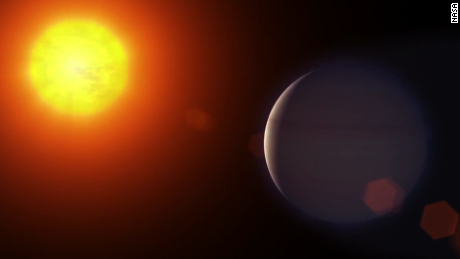美国宇航局:2025年或找到外星人痕迹(双语)
 美国宇航局表示2025年或许可找到外星人痕迹
美国宇航局表示2025年或许可找到外星人痕迹They may not be "Star Trek"-type extraterrestrials, but we may be close to finding evidence of alien life, a NASA scientist says.
或许《星际穿越》里面那样的外星人并不存在,但我们也许即将找到外星人存在的证据了。美国宇航局一名科学家这样说道。
"I think we’re going to have strong indications of life beyond Earth within a decade, and I think we’re going to have definitive evidence within 20 to 30 years," NASA chief scientist Ellen Stofan said Tuesday during a panel discussion on water in the universe。
“我认为,不出10年我们就会发现地外生命存在的有力证据,20到30年内,我们会掌握确凿证据。”美国宇航局首席科学家艾伦?斯托芬本周二在宇宙之水专题讨论会上这样说道。
"We know where to look. We know how to look," she said. "In most cases, we have the technology, and we’re on a path to implementing it. And so I think we’re definitely on the road."
“我们知道方向在哪儿。我们也知道方法是什么,”她说道。“大多数情况下,我们有技术,不断探索。我坚信我们在正确的道路上。”
NASA released a graphic noting that scientists have found evidence or indications of water on a number of celestial bodies, including the dwarf planet Ceres and Jupiter’s moon Europa。
美国宇航局发布了一张图片,注明科学家已经在很多天体上找到水存在的证据或迹象。包括矮行星谷神星和木星的卫星欧罗巴。
The Hubble Space Telescope has been key to the discoveries, NASA said in a news release."Scientists using NASA’s Hubble Space Telescope recently provided powerful evidence that (Jupiter’s moon) Ganymede has a saltwater, sub-surface ocean, likely sandwiched between two layers of ice," the agency noted。
美国宇航局新发布的消息显示哈勃太空望远镜在这些发现中起着至关重要的作用。该局公布:“最近科学家运用美国宇航局的哈勃太空望远镜发现了木星的卫星木卫三地下有咸水汪洋,像三明治一样夹杂在两层冰之间”。
There are some caveats involved, of course. NASA isn’t talking about intelligent alien civilizations from the Alpha Quadrant; it’s referring to microorganisms。
当然,这里面也有一些声明。美国宇航局表示他们并不是在讨论来自银河系的外星智慧,他们所说的是微生物。
"We are not talking about little green men," Stofan said at the panel. "We are talking about little microbes."
“我们并不是在说小绿人(想象中的地球以外的人)”,斯托芬在讨论会上说道。“我们口中的地外生命是微生物”。
Still, former astronaut John Grunsfeld said it’s an exciting time -- and he thinks it’s just a matter of time before we find life outside our solar system as well。
曾是宇航员的约翰?格伦斯菲尔德也同样认为这是个激动人心的时刻,并且认为找到太阳系以外的生命只是时间问题。
"I think we’re one generation away in our solar system, whether it’s on an icy moon or on Mars, and one generation on a planet around a nearby star," he said。
“我认为我们下一代就可以走到太阳系,不管是在冰冷的月亮上还是火星上,而下下代就可以踏上附近的星球上,”他表示。
And, he added, who knows what that life will look like?
他还补充道,谁知道那儿的生活是什么样子的?
"Once we get out beyond Mars, the likelihood that it’s similar to Earth because we share that material gets very, very low," he said. "And I think that’s where it starts getting exceptionally exciting."
“一旦我们走出火星,那个星球与地球的相似性变得非常小,因为星球的组成物质不同,”他说道。“但我认为这才变得更有趣更刺激。”
- 美丽达人注意:使用眼线笔会影响视力(双语)2015-04-12 11:41
- 双语:艾玛示范右侧脸比左侧脸照相美(组图)2015-04-12 10:57
- 双语:研究发现笑声能增进陌生人间的感情2015-04-12 10:24
- 双语:揭秘美国佬如何分分钟搭讪漂亮妹子2015-04-11 10:08
- 囧研究:世界第一汉堡起源中国肉夹馍(双语)2015-04-11 08:49

